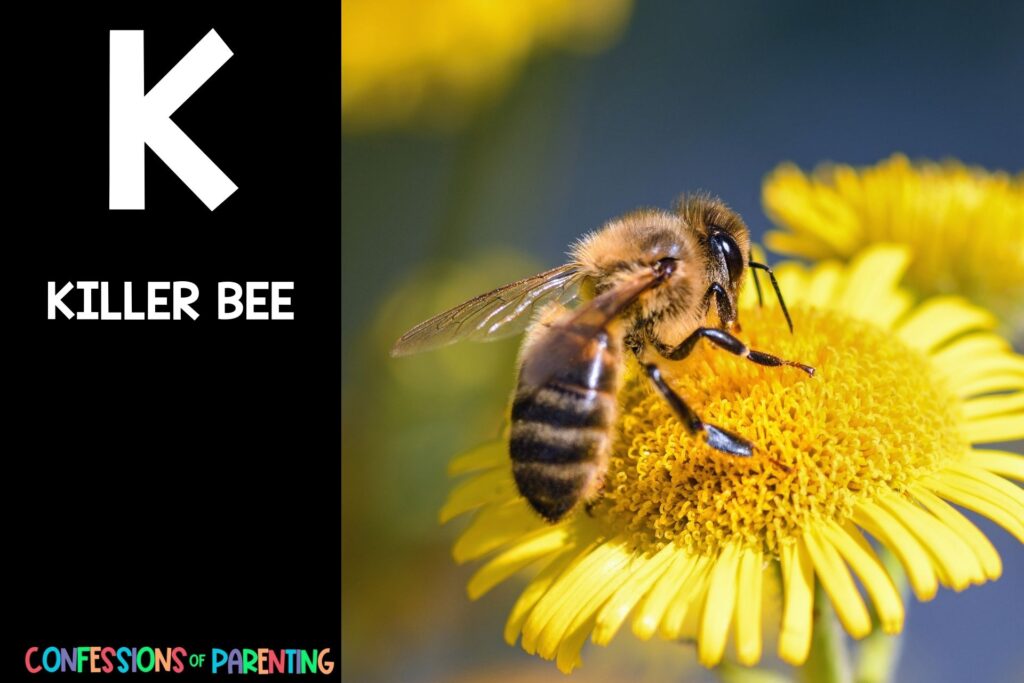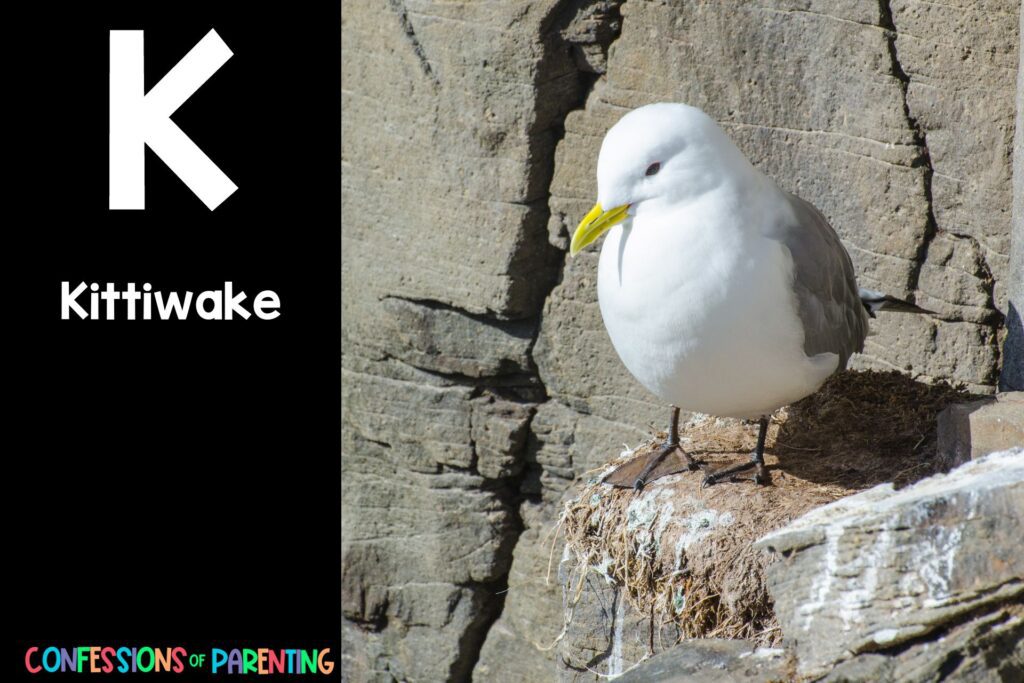There are so many exciting animals in the world! My kids love to play games where they think of an animal that begins with a certain letter. They then imagine what their life would be like if they were that animal. This list of Animals That Begin with K is the perfect addition to their game to help them find just the right animal! Kids get to learn cool facts about their favorite animals and learn about new and exciting animals. Take a look at this list of animals that begin with K and see where the game takes you!

Love learning about animals? Check out our animals that begin with J.
Commonly Known Animals That Begin With K
There are so many well known animals that begin with K. Check out this list with some fun facts about each animal.

Kangaroo
Did you know baby kangaroos are called joeys? They’re only the size of a gummy bear when they’re born! They live in their mother’s pouch until they are six months old and ready to take on the world independently. Kangaroos are herbivores, which means that they eat leaves and grass for their main meals. You may be impressed to know that a large kangaroo can travel 25 feet in one jump! There are 60 different kinds of kangaroos, and they’re all different sizes and colors. They can grow as tall as a man or as small as a rabbit.
Kiwi
A Kiwi is a bird from New Zealand, although it’s also the name of a sweet citrus fruit! One interesting fact about the Kiwi bird is that it doesn’t fly. Their feathers are looser on their bodies like hair. They can live for a long time, up to 50 years! Unlike other birds, they are never fed by their parents. They have to learn quickly how to fend for themselves and get their own food. There are only 70,000 Kiwis alive in the world today. Because they have many predators like dogs and cats, they’re critically endangered.

Killer bee
Even though the killer bee has a scary-sounding name, it’s no more dangerous than the average honeybee! The Killer Bee is also known as the Africanized Honeybee and comes from Eastern Africa. They can now be found all over the United States in tight-knit hives. What’s interesting is that some bee experts believe that they are better at pollinating plants and making honey than the average bee! Killer Bees live an average of one to two months. The queen of the hive lives far longer than her drones, however! She can live up to three years!
Krill
Krill are teeny-tiny crustaceans that look a lot like shrimp. Even though they are small, there are a ton of them in the Southern Ocean. Experts think that there are more than 700 trillion fully grown Krill swimming in the Southern Ocean. Because there are so many of them, their weight adds up to about the same as everyone in the world put together! One remarkable fact about Krill is that their groups can be seen from outer space. From here on Earth, they can be seen in the dark waters because of bioluminescence. This means that they produce their own light, like fireflies of the sea.
Komodo Dragon
Komodo Dragons are powerful hunters with a venomous bite. You wouldn’t want to meet one of these huge predators in the wild! They use their tongues to taste nearby food sources in the air. They can run sprints to catch their prey, but they won’t be running marathons any time soon. If they have to run to seek shelter, they throw up! This makes them lighter, which allows them to move faster. In the wild, Komodo Dragons live in Indonesia. Otherwise, they’re only found in captivity, including in many zoos around the United States. Scientists think Komodo Dragons can live up to 30 years in the wild.

Keel-billed Toucan
The Keel-billed Toucan can be found in Central and South America. They are easily identified by their large colorful bill and black body with a yellow neck. After they hatch, it takes about 2.5 months to fully form their beaks and leave the nest. The keel-billed toucan prefers to live in high-altitude rainforests with other toucans. When they sleep, they tuck their beaks into their wings to keep their body temperature steady. Keel-billed toucans are extremely social and love to have fun with other birds by tossing fruit to each other to catch.
Koi
Many backyard ponds have Koi fish in them. They are originally from Japan. In Japanese, Koi means “carp,” the cousin to today’s koi fish. Even though many people think that koi are just big goldfish, they’re not the same fish. Koi live in freshwater ponds and can grow up to three feet long. Koi are omnivorous, which means that they will eat lots of different things like bugs, algae, and other plants. Koi can live about 40 years. One really cool fact about Koi is that the oldest Koi to ever have lived was about 230 years old!

Killer Whale
The Killer Whale, also known as an Orca, is a beautiful black and white whale. It is a part of the dolphin family and is one of the kings of the ocean! It can live in any of the oceans in the world. The killer whale changes its diet based on what’s available in the ecosystem. A family of killer whales is called a pod. A pod of whales has less than 40 whales in it at one time. Can you imagine having a family that big? Like other members of the dolphin family, the killer whale uses echolocation (reflecting sound off of surfaces) to find its food and talk to other whales.
Kodiak Bear
Kodiak Bears are the largest bears in the world! They can stand over 10 feet tall when they are on two feet! They’re also quite heavy. They can weigh up to 1,500 pounds. That’s the same size as a grand piano! Most Kodiak Bears hibernate in their dens from October until April, but new momma bears will stay in their dens with their cubs until June to make sure that they’re big enough to explore the world. Even though they prefer to be alone, Kodiak Bears are often found together in feeding areas. They have their own language and can talk to other bears, which helps them avoid fights with other grumpy bears.
Koala
With their fluffy gray fur, Koalas are easily recognizable around the world. They are originally from Australia, but they can also be seen in many zoos. Even though people call Koalas “bears.” they are more like Kangaroos because of their marsupial traits. Mothers carry their young babies (called Joeys, like the kangaroos) in special pouches until they are fully grown and ready to face the world. If you go to see a Koala at the zoo, you’ll probably see him sleeping. That’s because they sleep 18-20 hours a day! This is because their diet of leaves doesn’t give them very much energy, so they need more rest than other mammals.

Kentucky Warbler
Like its name suggests, the Kentucky Warbler is found all over the southeastern United States. It received the honor of being known as the “Kentucky” warbler when it was first discovered in, you guessed it, Kentucky. It is a small birth with bright yellow and black markings. The Kentucky Warbler prefers to eat insects and hunts for them in leaves that fall to the ground. One cool fact about the Kentucky Warbler is that the male songbird chooses one song type to sing and sticks with it for the rest of his life!
Kitten
Kittens are a common household pet because they’re easy to train to use a litter box and are very smart! In the first three months they’re alive, they learn to walk and jump, use a litter box, and hunt for food. When kittens are born, their eyes are sealed shut to protect them. They’re still developing and need about another week before they can open. When they do open, all kittens have blue eyes. Within the first year or so, the color usually changes into yellow. With the exception of sight, kittens have excellent senses. Their hearing is three times better than humans!
King Cobra
King Cobras are the longest venomous snakes in the world. In fact, they can reach up to 18 feet long! Their length makes them an extra scary predator because they lift their bodies to stand tall when they are ready to strike. Luckily, they are scared of people and will either hide or hiss to try to warn people to stay away. King Cobras are carnivores. They mainly eat rats, lizards, and small birds. Some herpetologists (someone who studies reptiles and amphibians) believe that King Cobras mate with one partner and stay with their partner for their whole lives. That’s nearly 20 years!

King Crab
If you’ve ever eaten crab, you might have eaten a King Crab! There are over 120 different species of King Crabs. King Crabs hatch from eggs laid by the mother crab. She can lay up to 500,000 eggs in one year! Although King Crabs look like little worms when they hatch, they grow their shells in the first few months they’re alive. Their shells cover most of their body and are made of calcium. Did you know crabs shed their shells as they grow? They usually are fully grown by four or five years old, but they can live up to 30 years!
King Penguin
King Penguins are easily identified by the bright orange feathering on their head and chest. They live near oceans all over the world, particularly in the Antarctic. Groups of penguins are called a “waddle” if they are on land or a “raft” if they are in water. Unlike other birds, King Penguins do not build nests. They prefer to stand tall, with the egg resting on the tops of their feet. King Penguins have an extra patch of skin that acts like a blanket to keep the eggs toasty. Penguin chicks are hatched without any feathers. They grow their first set of soft down (feathers) in the first week. The down isn’t waterproof though, so they have to depend on their parents and other members of the waddle to keep them safe. Their waterproof feathers come in when the chick is about a year old.
Zoo Animals That Begin With K
I bet you didn’t know that there were so many zoo animals that begin with K. Check out this list to see how many of these animals you have seen at the zoo.

- Kagu
- Kangal Shepherd Dog
- Kangaroo rat
- Katydid
- Kauri snout beetle
- Kea
- Keagle
- Kenyan Sand Boa
- Kestrel
- King Vulture

- Kinkajou
- Kirk’s Dik-Dik
- Kit Fox
- Klipspringer
- Knight Anole
- Knob-tailed gecko
- Kookabura
- Kori Bustard
- Kudu
Other Animals That Start With K
This list of animals that begin with K are a little less known than the rest. How many of these less commonly known animals do you know?

- Kafue lechwe
- Kai Ken
- Kaibab squirrel
- Kakapo
- Kakariki
- Kalahari Meerkat
- Kalahari scrub robin
- Kalligrammatid lacewing
- Kaluga Sturgeon
- Kamehameha Butterfly
- Kanchil
- Kangaroo fish
- Kangaroo mouse
- Karakul sheep
- Karner blue butterfly
- Karoo Lark
- Karoo prinia
- Karoo Thrush
- Karwar fish
- Kashmir Flycatcher

- Kashmir musk deer
- Kaua’i ‘Ō‘ō
- Kavango Coppery Sunbird
- Keelback sea snake
- Keeltail needlefish
- Keeshond
- Kelaart’s long-clawed shrew
- Kelp bass
- Kelp crab
- Kelp fly
- Kelp Greenling
- Kelp Gull
- Kelp snail
- Kelp surfperch
- Kemp’s ridley sea turtle
- Kenk’s amphipod
- Kentish Plover
- Kermode Bear
- Kerry Blue Terrier
- Keta Salmon

- Key West Quail-Dove
- Key Deer
- Keyhole Cichlid
- Keyhole wasp
- Khao Manee
- Khapra Beetle
- Khasi pine blue butterfly
- Kiang
- Kibale red swallowtail
- Kiko Goat
- Kilifia acuminata ant
- Killdeer
- Killer Clown Ball Python
- Killifish
- Kinabalu Giant Red Leech
- Kinder Goat
- King angelfish
- King colobus
- King Cricket
- King Eider

- King Snake
- King Mackerel
- King Quail
- King Ragworm
- King Rat Snake
- King Salmon
- King Shepherd
- Kingfish
- Kingfisher
- Kingklip
- Kinnaridae (walking stick insect family)
- Kinzelbach’s spider
- Kipunji
- Kirkaldy’s leafhopper
- Kirtland’s snake
- Kishu
- Kissing Bugs
- Kissing gourami
- Kite
- Kitefin Shark
- Kitlope grizzly

- Kittiwake
- Kitti’s hog-nosed bat
- Kivu Shrew
- Kiwi fruit bug
- Klaas’s Cuckoo
- Klamath weed beetle
- Klipspringer fish
- Knifefish
- Knifetooth sawfish
- Knight moth
- Knobbed hornbill
- Knobbed sea star
- Knobbed weevil
- Knobbed whelk
- Knot (bird)
- Knot-horned sawfly
- Knysna seahorse
- Koa bug
- Koa seedworm
- Kob

- Kodkod
- Koel
- Kokako
- Kokanee Salmon
- Komati River Frog
- Komondor
- Kondana soft-furred rat
- Kooikerhondje
- Koolie
- Korean Field Mouse
- Korean Hare
- Korean Jindo
- Korean Water Deer
- Korinch’s Rat
- Kouprey
- Kowari
- Kraatzian leaf beetle
- Krait
- Kroyer’s Deep-Sea Anglerfish
- Kuhl’s flying gecko

- Kuhl’s flying squirrel
- Kuhl’s pipistrelle
- Kuhl’s stingray
- Kulan
- Kulga Sturgeon
- Kumbara nightjar
- Kumlien’s Gull
- Kunekune Pig
- Kuril seal
- Kuroko honey bee
- Kusnezov’s ant
- Kwongan dunnart
- Kyrgyz Tarpan
There you have it! A huge list of animals that begin with K to learn and to have fun exploring with the kids. Did we forget an animal? Be sure to add any other animals that begin with K to the list!
Do you want to learn about other interesting animals? Be sure to check out our other lists of animals!
- Awesome Animals that Start with A
- 230 Curious Animals That Start With C
- 115 Exciting Animals That Start With E
- 184 Intriguing Animals that Start with G
- 128 Fascinating Animals That Begin with J
- 187 Amazing Animals that Begin with K
- 249 Interesting Animals That Begin with L
- 163 Marvelous Animals that Start with M
- 373 Spectacular Animals that Start with S
- 155 Terrific Animals that Start with T
- 98 Wonderful Animals that Start with W
- 24 X-cellent Animals That Start With X
- 32 Fantastic Animals That Start With Y

Michele Tripple is a renowned author and expert in the fields of parenting, relationships, and personal development. With her degree in marriage and family studies, her experience as a Family Life Educator, and over a decade of experience as a professional writer, Michele has authored books that provide practical advice and insights into improving family dynamics and personal growth. Her work is celebrated for its blend of research-driven information and relatable, real-world applications. Michele has been a keynote speaker at conferences and has contributed to numerous publications and media outlets, solidifying her reputation as an authoritative voice in her field and helping families build relationships.
